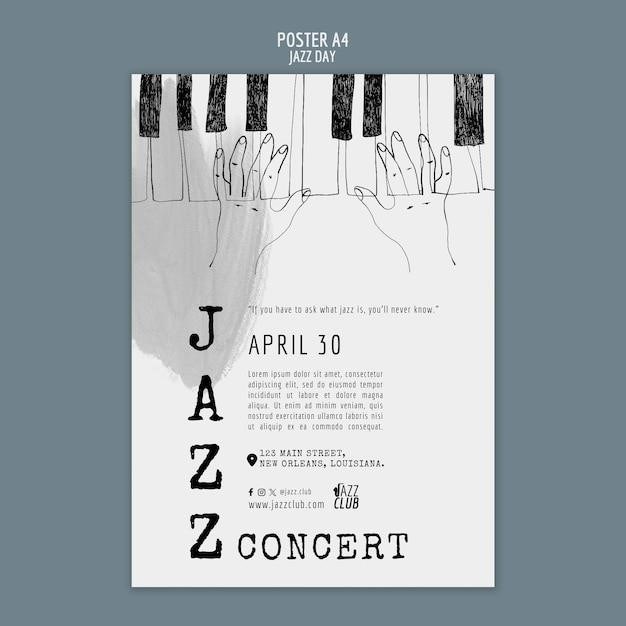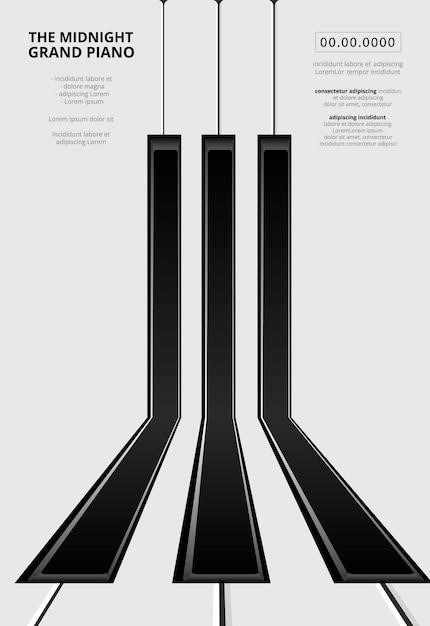
let it be piano chords pdf
Let It Be Piano Chords⁚ A Comprehensive Guide
Embark on a musical journey with this comprehensive guide to mastering the piano chords of the Beatles’ timeless classic, “Let It Be․” Whether you’re a seasoned musician or a curious beginner, this resource provides a step-by-step exploration of the song’s chord structure, offering insights into the basic chords, inversions, and progressions that make this song so iconic․ Dive into the world of “Let It Be” and discover the power of simplicity in creating beautiful music․
Introduction⁚ The Enduring Appeal of “Let It Be”
“Let It Be,” the iconic Beatles ballad released in 1970, has transcended generations with its simple yet profound message of hope and serenity․ The song’s enduring appeal lies not only in its lyrics but also in its captivating melody and the elegant simplicity of its piano chords․ The piano chords, with their gentle progressions and soothing harmonies, provide the foundation for the song’s timeless beauty, inviting listeners to embrace a sense of peace and release․ The song’s enduring legacy is a testament to the power of music to evoke profound emotions and connect with people across cultures and time․ This guide delves into the heart of “Let It Be,” unveiling the secrets behind its captivating piano chords and empowering you to recreate the song’s essence on your own instrument․
The Chords of “Let It Be”⁚ A Breakdown
The piano chords in “Let It Be” are remarkably simple, yet they create a profound emotional impact․ The song primarily utilizes four basic chords⁚ C major, G major, Am (A minor), and F major․ These chords, when played in a specific order, create a comforting and familiar progression that resonates with listeners․ The simplicity of these chords allows for easy memorization and playing, making “Let It Be” a popular choice for beginner pianists․ However, the beauty of the song lies in its subtle variations and nuances․ These variations are achieved through the strategic use of chord inversions and rhythmic embellishments, adding depth and richness to the song’s melodic landscape․ These subtle shifts and alterations in the chords, often imperceptible to the untrained ear, contribute to the song’s overall emotional impact, making it a timeless classic that continues to captivate audiences worldwide․
The Basic Chords
The foundation of “Let It Be” rests upon four fundamental chords⁚ C major, G major, A minor, and F major․ These chords form the backbone of the song’s progression and are relatively easy to learn, making it an accessible choice for aspiring pianists․ C major, the first chord in the progression, is a foundational chord in music theory․ G major, the second chord, introduces a brighter, more uplifting quality․ A minor, the third chord, brings a sense of melancholy and introspection․ Finally, F major, the fourth chord, acts as a resolution, providing a sense of closure and completeness․ Each chord contributes to the overall emotional landscape of the song, creating a poignant and unforgettable musical experience․
Inversions and Variations
While the basic four chords form the core of “Let It Be,” exploring inversions and variations adds depth and texture to the song․ Inversions refer to different ways of playing the same chord by rearranging the notes․ For example, a C major chord can be played in root position (C-E-G), first inversion (E-G-C), or second inversion (G-C-E)․ This creates subtle changes in the sound and adds a touch of sophistication to the arrangement․
Variations, on the other hand, involve adding or removing notes from the basic chord structure․ This can create a more complex sound and introduce new harmonic possibilities․ For instance, adding a seventh note to a major chord creates a dominant seventh chord (Cmaj7)․ Inversions and variations, when employed judiciously, can bring a fresh perspective to the familiar chords, adding depth and complexity to the musical journey․
Chord Progressions and Structure
The heart of “Let It Be” lies in its simple yet effective chord progressions․ The song predominantly uses a four-chord progression, a foundation for countless popular songs․ This progression is based on the I-IV-V-vi chord structure, where I represents the tonic chord (C major in this case), IV represents the subdominant chord (F major), V represents the dominant chord (G major), and vi represents the minor chord a minor third below the tonic (Am)․ This cyclical progression creates a sense of movement and resolution, driving the song forward with a captivating melody․
The song’s structure is straightforward, consisting of verses, choruses, and bridges․ Each section features variations on the basic chord progression, adding subtle twists and turns to the musical landscape․ The verses typically use the I-IV-V-vi progression, while the choruses often introduce a more extended progression, sometimes incorporating inversions or variations of the basic chords․ This interplay between the familiar and the unexpected keeps the song engaging and memorable․
Playing “Let It Be” with a PDF Chord Chart
A PDF chord chart is an invaluable tool for learning and playing “Let It Be” on the piano․ It provides a visual representation of the chord progressions, making it easier to follow along with the song; Many online resources offer free printable PDF chord charts for “Let It Be,” often featuring clear diagrams and fingerings for each chord․ These charts typically present the chords in a standard notation format, using Roman numerals to represent the chords within the key of the song (C major in this case)․ They may also include additional information like chord inversions, suggested rhythms, and even lyrics for reference․
When using a PDF chord chart, it’s essential to understand the basics of chord notation and fingerings․ Practice reading the chart and identifying the chords before attempting to play the song․ Start by learning the basic four-chord progression and then gradually incorporate the variations and transitions found in the verses, choruses, and bridges․ It’s also helpful to listen to the song while following the chart, paying attention to the timing and dynamics of the chords․ With practice and dedication, you’ll be able to play “Let It Be” confidently using a PDF chord chart as your guide․
Tips for Learning the Chords
Learning the chords for “Let It Be” can be an enjoyable and rewarding experience․ To make the process smoother, consider these tips⁚
Start with the Basics⁚ Begin by mastering the basic four chords (C major, G major, Am, and F major) that form the core of the song․ Practice playing these chords individually, focusing on smooth transitions between them․
Practice Fingerings⁚ Each chord has specific finger placements that are essential for playing smoothly․ Refer to the PDF chord chart and practice the fingerings diligently․
Break It Down⁚ Divide the song into sections and learn the chords for each section individually․ Start with the verses, then move on to the choruses, bridges, and outros․

Listen and Analyze⁚ Pay close attention to the song while you practice․ Notice how the chords are played, the timing, and the dynamics․ This will help you understand the song’s musical structure and nuances․
Record Yourself⁚ Recording your playing allows you to identify areas for improvement․ Listen back and pinpoint any inconsistencies, incorrect fingerings, or timing issues․
Be Patient and Persistent⁚ Learning new chords takes time and practice․ Don’t get discouraged if you don’t get it right away․ Keep practicing and gradually build your skills․
Enjoy the Process⁚ Learning “Let It Be” on the piano should be a fulfilling experience; Focus on the joy of making music and celebrate your progress along the way․
Beyond the Basic Chords⁚ Adding Depth and Nuance
While the basic four chords of “Let It Be” provide a solid foundation, exploring variations and embellishments can add a new dimension to your playing․ Here’s how to infuse your performance with depth and nuance⁚
Inversions⁚ Experiment with inversions of the basic chords to create melodic and harmonic variations․ For example, instead of playing a standard C major chord (C-E-G), try playing a first inversion (E-G-C) or a second inversion (G-C-E)․
Seventh Chords⁚ Adding a seventh note to a major or minor chord creates a richer, more complex sound․ For instance, you could add a B flat to the C major chord to create a C major 7th chord (C-E-G-B flat)․
Suspensions⁚ Suspensions introduce a momentary tension before resolving to a more stable chord․ For instance, instead of a standard G major chord (G-B-D), play a Gsus4 chord (G-D-B), which replaces the B with a D․
Passing Chords⁚ Introduce passing chords between the main chords to create a smoother flow and add melodic interest․ For example, you could add a Dm chord between the C major and G major chords․
Dynamics⁚ Vary the volume and intensity of your playing to create emotional impact․ Use soft, gentle touches for the verses and build up to a more powerful sound for the choruses․
Rhythmic Variations⁚ Explore different rhythmic patterns within the song․ You could add syncopation, accents, or even experiment with different time signatures․
Improvisation⁚ Once you’re comfortable with the basic chords and variations, try improvising over the song; This allows you to express your own musical ideas and add a personal touch to your performance․
Resources for Further Exploration
The world of music theory and piano playing is vast and exciting․ If you’re eager to delve deeper into the intricacies of “Let It Be” and beyond, here are some resources to ignite your musical journey⁚
Online Music Theory Resources⁚ Websites like Musictheory․net, Teoria․com, and 8notes․com offer comprehensive music theory lessons, chord diagrams, and interactive exercises that can enhance your understanding of chords, scales, and progressions․
Piano Chord Chart PDFs⁚ Numerous websites offer free printable piano chord charts, including those specifically designed for beginners․ These charts can serve as valuable reference guides for learning new chords and understanding their structure․
Piano Apps and Software⁚ Explore piano learning apps like Simply Piano, Flowkey, and Pianote, which offer interactive lessons, chord diagrams, and play-along features․ Piano software like GarageBand and Logic Pro can also be used for composing and practicing with virtual instruments․
Music Books and Tutorials⁚ Seek out piano books and tutorials dedicated to learning popular songs, including “Let It Be․” These resources often provide detailed chord charts, fingerings, and step-by-step instructions for playing the song․
Music Teachers and Online Lessons⁚ Consider taking private piano lessons or enrolling in online courses to receive personalized guidance and instruction from experienced musicians․ Online platforms like Udemy and Coursera offer a wide range of music theory and piano lessons․
Music Communities and Forums⁚ Join online music communities and forums to connect with fellow musicians, share your experiences, and learn from others․ Platforms like Reddit’s r/piano and the Guitar Tab community offer a supportive environment for musicians of all levels․
Music Videos and Tutorials⁚ Numerous online platforms like YouTube and Vimeo offer countless music videos and tutorials on playing piano, learning chords, and analyzing popular songs․
Embracing the Power of Simplicity
As you navigate the world of “Let It Be” piano chords, remember that the beauty of this song lies in its simplicity․ The core chords, G, Am, C, and D, form the foundation of a timeless melody that resonates with audiences of all ages․ While exploring inversions and variations can add depth and complexity, don’t lose sight of the power of these basic chords․
Embrace the simplicity of “Let It Be” as a gateway to understanding music theory and the joy of playing the piano․ The journey from learning the basic chords to mastering the intricacies of the song is a rewarding one, filled with moments of discovery and musical fulfillment․ Remember, music is about expression, and even the simplest chords can convey profound emotions when played with passion and heart․
So, whether you’re a seasoned musician or just starting your musical journey, let “Let It Be” be your guide․ Embrace the power of simplicity, and let the music flow through your fingers, creating a harmonious symphony of emotion and musical expression․